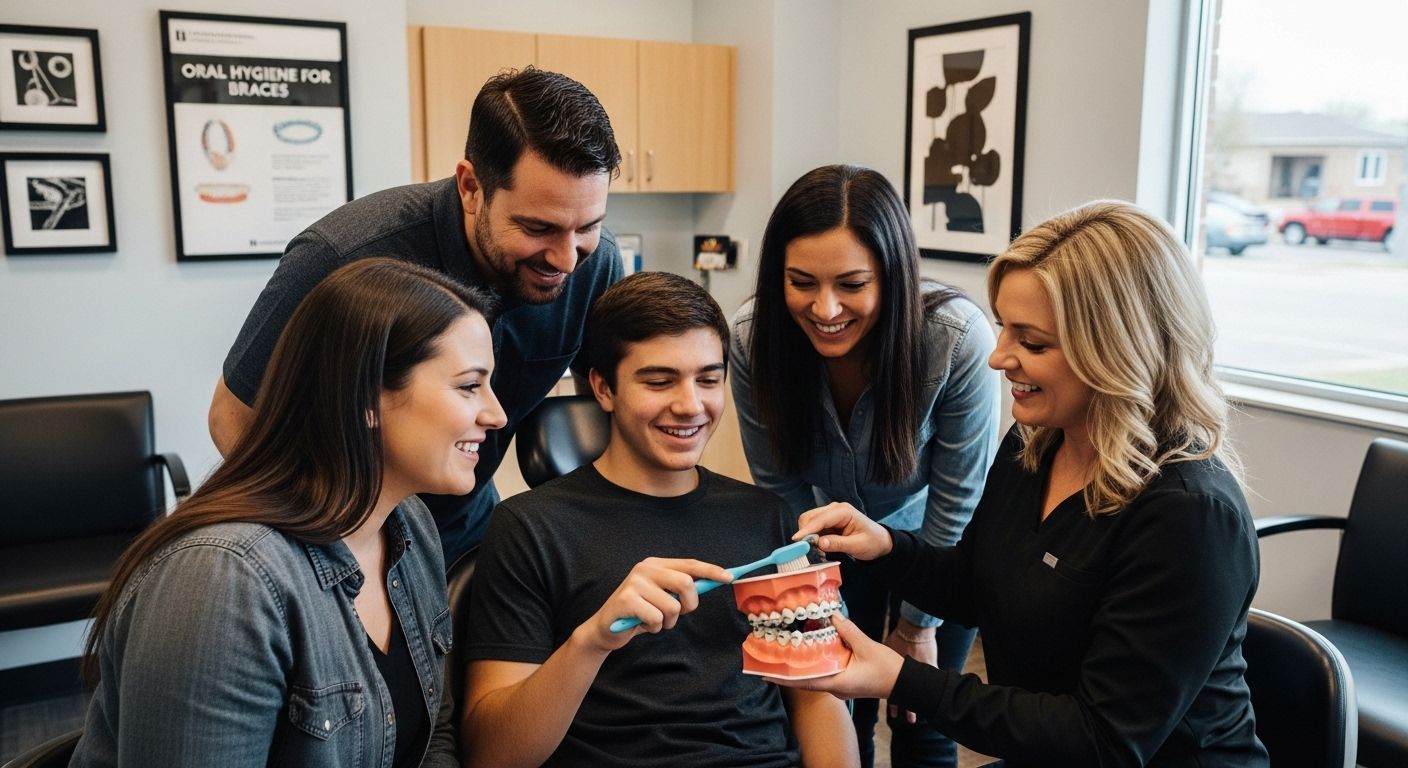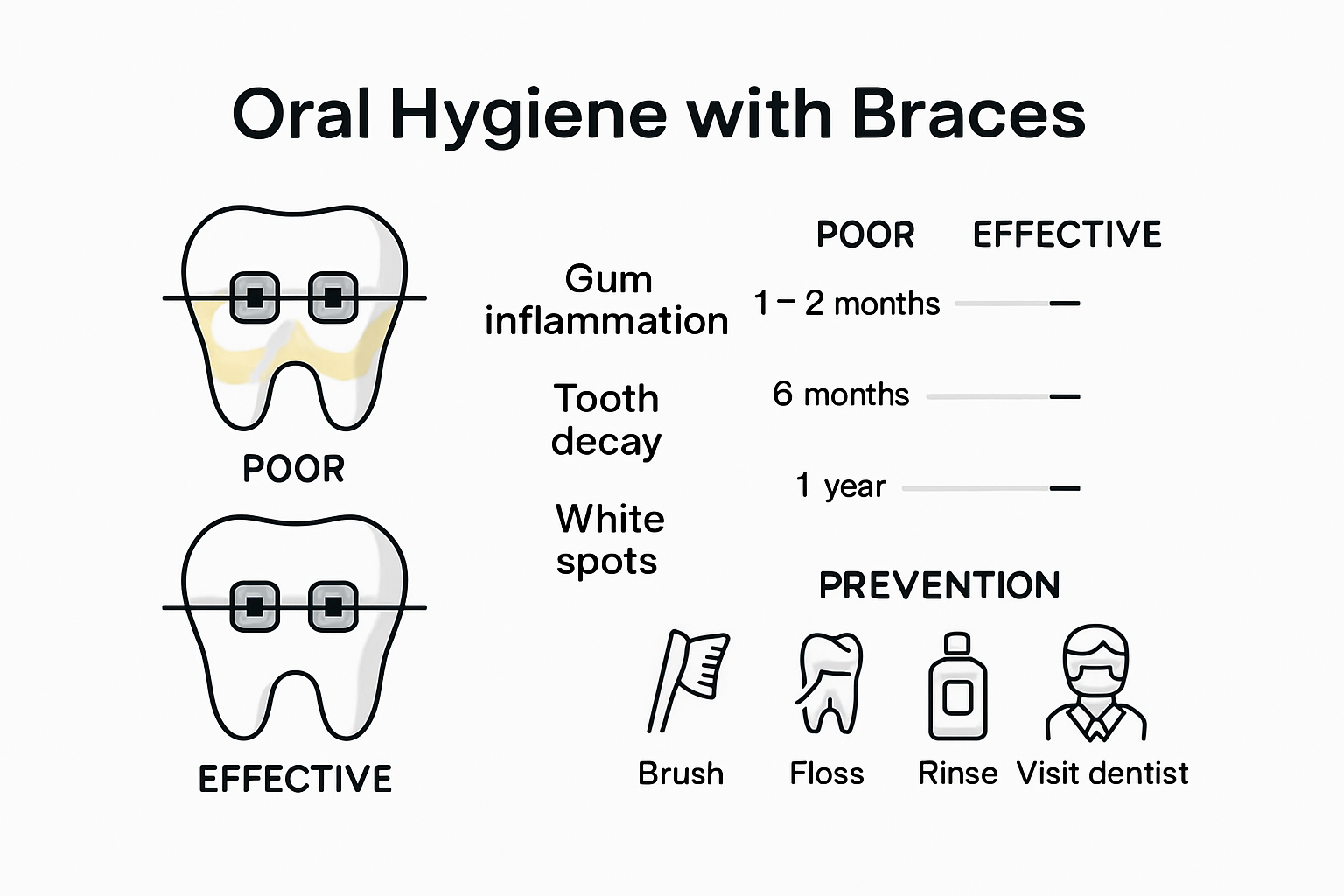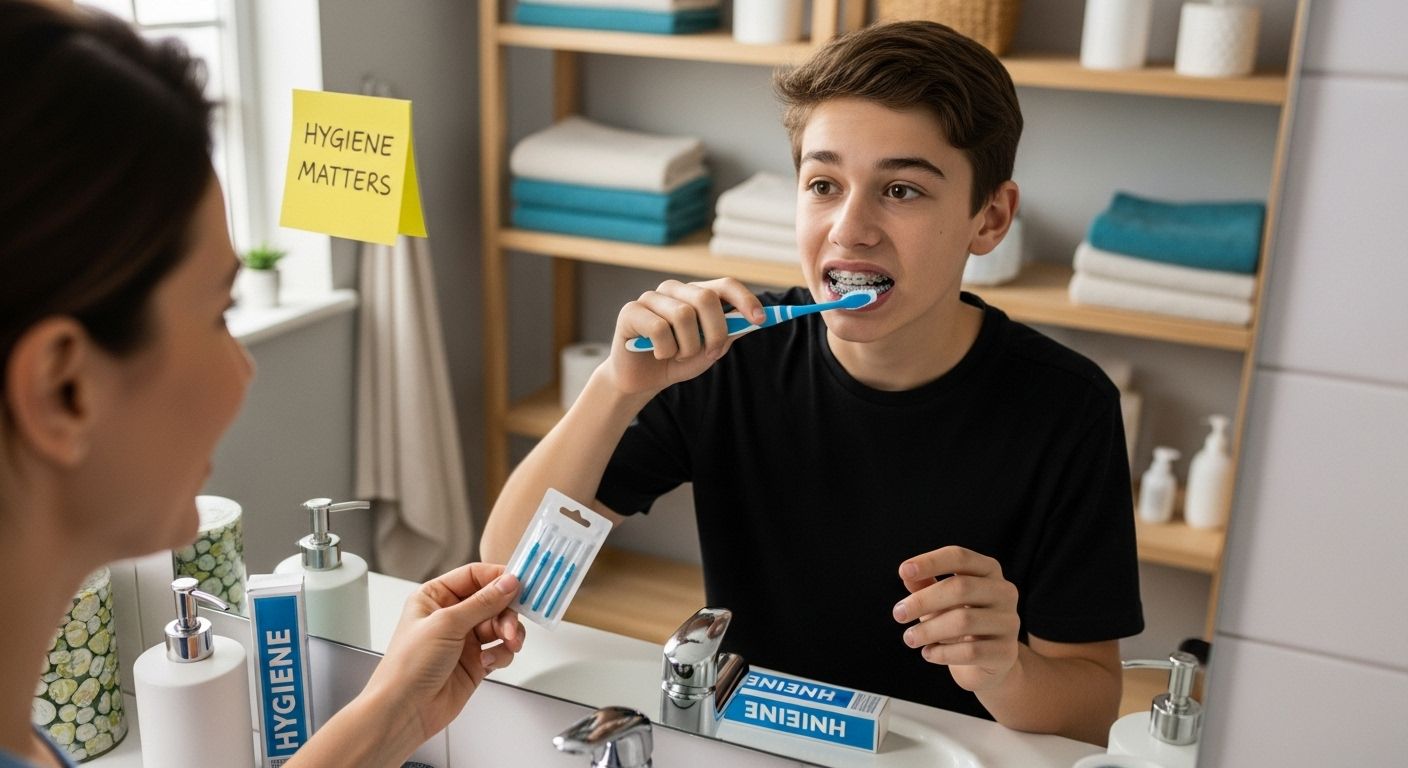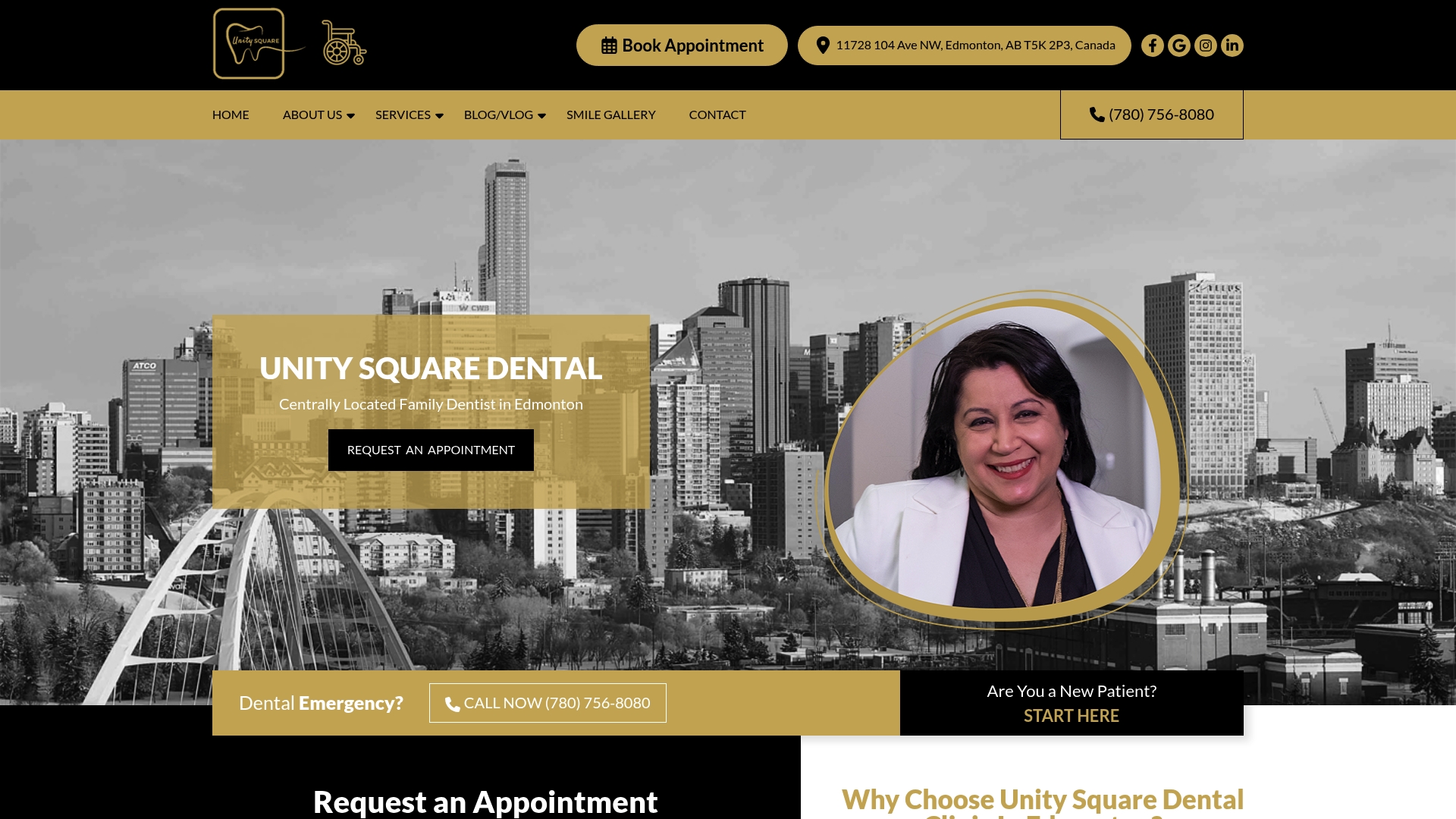
Braces can completely change a smile but they also make cleaning your teeth a lot tougher. Most people are surprised to learn that adolescents with braces face up to twice the risk of gum inflammation and tooth decay if they skip proper care. You might think brushing and flossing the old way is enough but missing just a few spots can leave behind white marks that last for years. Get this wrong and all that time spent straightening teeth could go to waste.
Table of Contents
- Why Oral Hygiene For Braces Matters
- Step-By-Step Brushing And Flossing Tips
- Choosing The Right Dental Products For Braces
- Special Care For Comfort And Emergency Situations
Quick Summary
| Takeaway | Explanation |
|---|---|
| Maintain rigorous oral hygiene with braces | Effective cleaning prevents decay and gum issues caused by brackets and wires. |
| Use specialized tools for cleaning | Orthodontic toothbrushes and water flossers enhance plaque removal and reach difficult areas. |
| Brush after every meal or at least twice daily | Consistent brushing is key to protecting enamel and supporting orthodontic progress. |
| Recognize minor discomfort from braces | Use orthodontic wax and pain relievers for temporary discomfort relief during adjustments. |
| Understand when to seek emergency care | Distinguish between minor irritations and true emergencies for timely professional assistance. |
Why Oral Hygiene for Braces Matters
Oral hygiene becomes significantly more complex when braces enter the picture. These orthodontic devices create numerous tiny spaces where food particles and bacteria can easily hide, making thorough cleaning essential for maintaining dental health. Understanding the critical importance of oral care during orthodontic treatment can prevent long term complications and ensure a successful straightening journey.
The Hidden Risks of Inadequate Oral Care with Braces
Braces create intricate metal or ceramic structures that interrupt the smooth surface of teeth, generating multiple hard to reach areas. The National Institute of Dental and Craniofacial Research emphasizes that without meticulous cleaning, patients risk developing serious dental problems. The brackets and wires trap food debris more effectively than natural teeth, accelerating plaque buildup and potentially leading to tooth decay, gingival inflammation, and unsightly white spot lesions.

The consequences of poor oral hygiene during orthodontic treatment extend beyond temporary discomfort. Neglecting proper cleaning can result in permanent enamel damage, increased tooth sensitivity, and potential reversal of orthodontic progress. Research published in the American Journal of Orthodontics and Dentofacial Orthopedics suggests that adolescent patients who integrate advanced cleaning technologies and consistent oral care protocols experience significantly lower rates of dental complications.
Comprehensive Oral Hygiene Strategies for Brace Wearers
Effective oral care with braces requires a multilayered approach. Patients must invest in specialized tools like interdental brushes, water flossers, and orthodontic-specific toothbrushes designed to navigate around brackets and wires. The our comprehensive guide on dental cleaning techniques can provide additional insights into maintaining optimal oral health.
The Illinois Department of Public Health highlights that preventing gingivitis demands more than standard brushing. Orthodontic patients should adopt techniques that address the unique challenges presented by braces, including angled brushing methods, thorough flossing with threaders, and potentially using antimicrobial mouthwashes to reduce bacterial accumulation.
Ultimately, oral hygiene for braces is not just about maintaining appearance but preserving long term dental health. By understanding the intricate relationship between orthodontic devices and potential dental risks, patients can proactively protect their smile and ensure the success of their teeth straightening journey.
Step-by-Step Brushing and Flossing Tips
Mastering oral hygiene with braces requires precision, patience, and the right techniques. The complexity of navigating around brackets and wires demands a systematic approach that ensures every tooth surface receives thorough cleaning. Patients must develop a meticulous routine that protects both their orthodontic investment and overall dental health.
Essential Tools for Effective Cleaning
Before beginning any cleaning routine, orthodontic patients need specialized equipment. The American Dental Association recommends investing in specific tools designed for braces. These include:
Here is a summary table that organizes the key cleaning tools recommended for brace wearers, including their features and primary purposes to help readers quickly compare their functions.
| Tool | Key Features | Primary Purpose |
|---|---|---|
| Orthodontic Toothbrush | V-shaped bristles, angled head | Clean around brackets and wires |
| Interdental Brush | Cone-shaped, fits between wires and teeth | Remove debris between brackets and teeth |
| Water Flosser | Powerful water streams | Dislodge trapped food, clean hard areas |
| Floss Threader | Stiff end for threading floss | Help floss beneath orthodontic wires |
| Fluoride Toothpaste | Contains fluoride for enamel protection | Strengthen enamel, prevent decalcification |
| Orthodontic Wax | Malleable, protective coating | Reduce irritation from brackets and wires |
| Fluoride Mouthwash | Liquid, daily rinse | Prevent white spots, reduce bacteria |
- Orthodontic Toothbrush: Featuring V-shaped bristles and specialized angles to clean around brackets
- Interdental Brushes: Small, cone-shaped brushes that fit between wires and teeth
- Water Flosser: Provides powerful water streams to dislodge trapped food particles
- Fluoride Toothpaste: Helps strengthen enamel and prevent decalcification
Comprehensive Brushing Technique
Proper brushing with braces requires a methodical approach. Research published in the Journal of Clinical Orthodontics suggests breaking down the process into manageable segments. Start by rinsing with water to loosen debris, then follow these steps:
This process table outlines the recommended step-by-step brushing technique for those with braces, helping reinforce each action for thorough and effective cleaning.
| Step | Action | Key Details |
|---|---|---|
| 1 | Rinse with water | Loosens debris around brackets and wires |
| 2 | Angle toothbrush at 45° to gums | Ensures contact with gum line |
| 3 | Use gentle, circular motions around each bracket | Cleans surfaces adjacent to brackets |
| 4 | Brush above and below each bracket | Targets difficult-to-reach areas |
| 5 | Spend at least 30 seconds on each quadrant | Promotes even, thorough cleaning |
| 6 | Brush chewing and inner tooth surfaces | Prevents buildup on all sides of each tooth |
- Hold your toothbrush at a 45-degree angle to the gums
- Use gentle, circular motions around each bracket
- Clean above and below each bracket thoroughly
- Spend at least 30 seconds on each quadrant of your mouth
- Brush the chewing surfaces and inner tooth surfaces
Patients should aim to brush after every meal, or at minimum, twice daily for at least two minutes. Our comprehensive guide on dental cleaning techniques offers additional insights into maintaining optimal oral hygiene.
Flossing becomes more challenging with braces but remains critically important. Orthodontic floss threaders or special orthodontic floss with a stiff end can help navigate around wires. Gently slide the floss between teeth, moving it up and down against each tooth surface. Take extra care not to apply excessive pressure that might damage brackets or wires.
Consistent practice transforms these techniques from challenging tasks to natural habits. Patients who develop disciplined oral care routines during orthodontic treatment not only protect their teeth but also ensure a smoother, more successful straightening process. Remember that each careful brushing and flossing session is an investment in a healthier, more confident smile.
Choosing the Right Dental Products for Braces
Selecting appropriate dental products is crucial for maintaining oral health during orthodontic treatment. The right tools can make a significant difference in cleaning effectiveness, comfort, and overall dental hygiene for patients wearing braces. Understanding the nuanced requirements of orthodontic care helps patients make informed choices about their dental products.
Essential Toothbrush Selection
Nationwide Children’s Hospital recommends using a small toothbrush with specific characteristics tailored for braces. Soft, polished nylon bristles with a flat brushing surface provide the most effective cleaning around brackets and wires. Electric toothbrushes can be particularly beneficial, offering consistent motion and improved plaque removal.
Patients should consider toothbrushes with the following features:
- Compact Head: Allows better navigation around brackets
- Soft Bristles: Prevents damage to gums and orthodontic equipment
- Angled Design: Helps reach difficult areas around braces
The Illinois Department of Public Health emphasizes the importance of using specialized orthodontic toothbrushes that can effectively clean around metal or ceramic brackets. For those seeking additional dental care insights, our comprehensive guide offers further recommendations.
Specialized Cleaning Tools
Beyond traditional toothbrushes, orthodontic patients require additional specialized tools. Interdental brushes become critical for cleaning between brackets and under wires. Water flossers offer an excellent alternative to traditional flossing, using powerful water streams to dislodge food particles and clean hard-to-reach areas.
Key additional tools include:
- Floss Threaders: Enable flossing beneath orthodontic wires
- Orthodontic Wax: Provides protection against bracket irritation
- Fluoride Mouthwash: Helps prevent decalcification and strengthens enamel
Oral hygiene with braces demands a comprehensive approach. Rutgers School of Dental Medicine highlights that regular use of these specialized tools can prevent plaque buildup, reduce the risk of tooth enamel damage, and minimize the potential for gingivitis.
Patients should view their dental product selection as an investment in their oral health. While the initial cost of specialized tools might seem higher, the long-term benefits of preventing dental complications far outweigh the expense. Consulting with an orthodontic professional can provide personalized recommendations tailored to individual dental needs and specific types of braces.

Special Care for Comfort and Emergency Situations
Orthodontic treatment presents unique challenges that extend beyond routine oral hygiene. Patients with braces must be prepared to manage unexpected discomfort and potential emergencies, understanding the difference between minor issues and situations requiring immediate professional attention. Proactive preparation and knowledge can significantly reduce anxiety and potential complications during orthodontic treatment.
Common Orthodontic Discomforts and Immediate Solutions
Dental Associates emphasize that most orthodontic issues are manageable with proper knowledge and preparedness. Patients frequently encounter challenges such as wire irritation, loose brackets, and minor soft tissue discomfort. Orthodontic wax becomes an essential tool in managing these situations, providing temporary relief by creating a protective barrier between brackets and sensitive oral tissues.
Key strategies for immediate comfort include:
- Orthodontic Wax Application: Covers sharp edges and reduces friction
- Salt Water Rinses: Alleviates soft tissue inflammation
- Over-the-Counter Pain Relievers: Manages initial adjustment discomfort
- Soft Food Diet: Reduces pressure during initial stages of treatment
Distinguishing Between Minor Issues and True Emergencies
Pennsylvania Orthodontic Associates provide critical guidance in identifying genuine orthodontic emergencies. While most situations can be temporarily managed at home, certain conditions demand immediate professional intervention. Our comprehensive patient care guide offers additional insights into managing unique dental challenges.
True orthodontic emergencies typically involve:
- Significant facial trauma
- Severe pain unresponsive to standard pain management
- Extensive bracket or wire damage
- Signs of infection or advanced inflammation
- Unexpected bleeding or swelling
Preventative Measures and Professional Support
Spokane Orthodontics recommends developing a proactive approach to potential complications. Patients should maintain regular communication with their orthodontic provider, schedule routine check-ups, and maintain a comprehensive emergency contact list. Keeping a dedicated orthodontic care kit with essential items like wax, pain relievers, and sterile gauze can provide immediate relief during unexpected situations.
Ultimately, successful orthodontic treatment requires a balanced approach of self-care, professional guidance, and preparedness. While emergencies are rare, understanding how to respond effectively can transform potential stress into manageable experiences. Patients should never hesitate to contact their orthodontic professional when uncertainty arises, ensuring their treatment remains smooth and comfortable.
Frequently Asked Questions
How can I maintain oral hygiene while wearing braces?
To maintain oral hygiene with braces, brush your teeth after every meal or at least twice daily using an orthodontic toothbrush. Use specialized cleaning tools like interdental brushes and water flossers to effectively remove plaque and food particles around brackets and wires.
What tools are essential for effective cleaning with braces?
Essential tools for effective cleaning with braces include an orthodontic toothbrush, interdental brushes, fluoride toothpaste, a water flosser, floss threaders for navigating around wires, and orthodontic wax to reduce irritation from brackets.
How often should I brush and floss my teeth while wearing braces?
You should brush your teeth after every meal or at least twice a day, ensuring you spend sufficient time (at least 2 minutes) on each quadrant of your mouth. Flossing should be done at least once daily to remove debris between teeth and around braces.
What are some common discomforts associated with braces, and how can I manage them?
Common discomforts from braces include wire irritation and loose brackets. You can manage these issues by applying orthodontic wax over sharp edges, using saltwater rinses to alleviate inflammation, and taking over-the-counter pain relievers for initial adjustment discomfort.
Protect Your Smile and Braces at Unity Square Dental
Brushing and flossing with braces can be overwhelming, especially when your family’s oral health is at stake. If you are worried about hard-to-reach spots, white marks, or the long-term impact of brackets and wires on your teeth, you are not alone. Many Edmonton families struggle to keep up with the unique cleaning routines and want expert support to avoid costly mistakes. Our team at Unity Square Dental understands your concerns because we help patients just like you achieve healthy, confident smiles every day. We use advanced tools and personalized care strategies to make oral hygiene with braces easier, more effective, and less stressful.

Why wait for problems to develop? Book a visit with our Edmonton dental team today through our main site and discover how our expertise in general dentistry, orthodontic care, and preventative appointments can secure your family’s oral health. Click now to experience compassionate, technology-driven support for braces care—and take the first step toward a bright, worry-free smile.
Recommended
- Dental Cleaning Frequency: Best Advice for Edmonton Families 2025 – Unity Square Dental
- How Often to Visit Dentist in Edmonton: 2025 Family Guide – Unity Square Dental
- Teeth Cleaning vs Whitening: Guide for Edmonton Families 2025 – Unity Square Dental
- Dental Care for Families in Edmonton: Your 2025 Guide – Unity Square Dental

